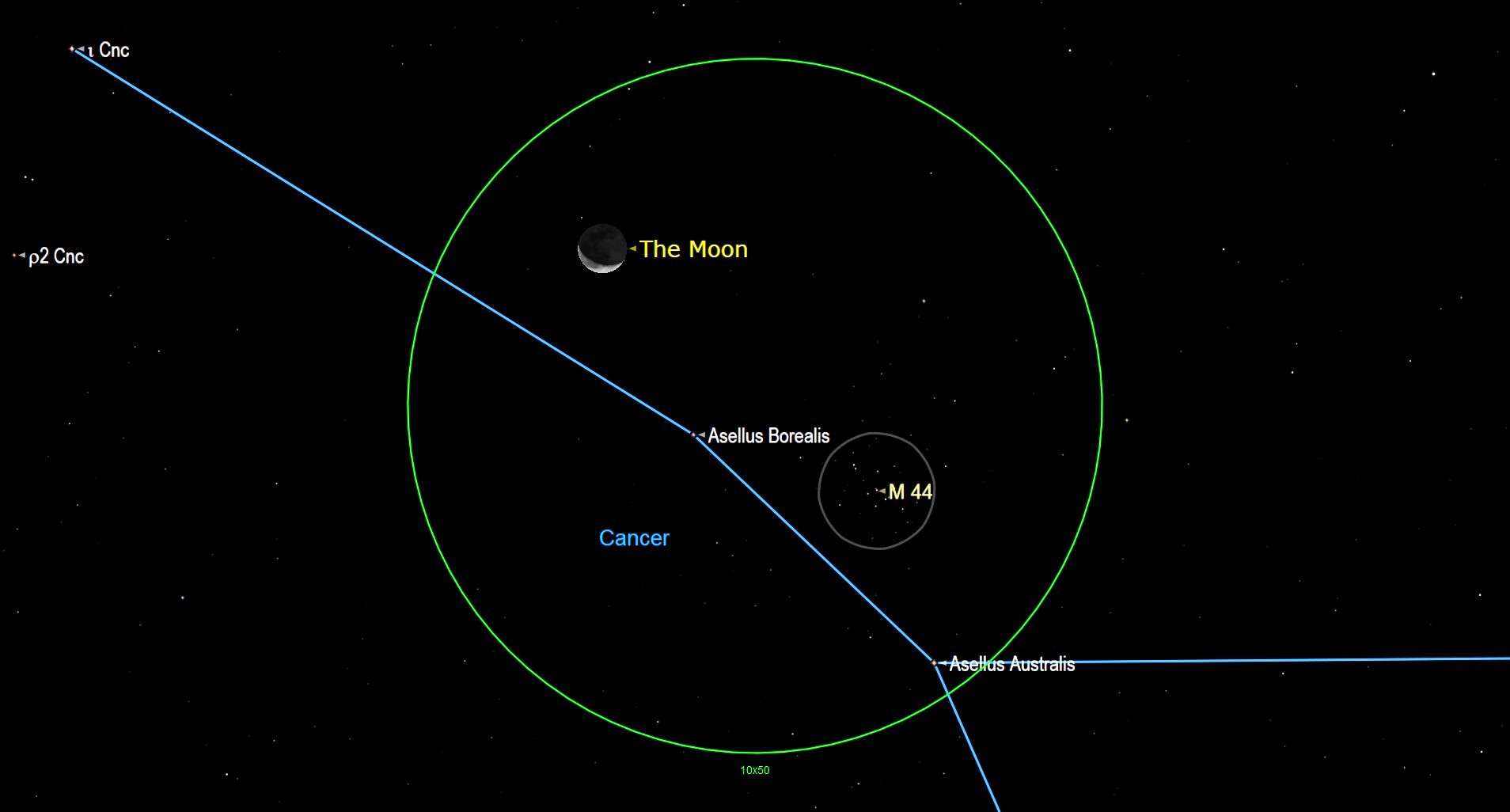See the moon buzz the Beehive cluster on Wednesday (Sept. 21)
Early risers on Wednesday will get to see the moon pass the Beehive cluster at the heart of the constellation Cancer.

In the early morning on Wednesday (Sept. 21), the moon will pass the Beehive Cluster, a collection of stars also known as Messier 44 (M44) in the constellation of Cancer.
The waning crescent moon will be around three degrees from the Beehive Cluster which itself spans a width equivalent to about three moons. (Your fist at arm's length equals around ten degrees in the sky).
The event should be visible with the naked eye as, though the moon is waning in its crescent phase (its bright side moving away from Earth) , it is still quite bright. Also, the Beehive cluster is visible to the naked eye with a magnitude of 3.7.
Related: Night sky, September 2022: What you can see tonight [maps]
Observing the moon as it passes the Beehive cluster with binoculars in a location with a dark sky, however, will reveal the cluster in greater detail allowing more of the stars in the 1,000-strong swarm to be seen.
At a distance of around 550 light-years away, the Beehive — or NGC 2632 as astronomers call it — is the closest open cluster to Earth. It is also one of the most populated examples of these collections of stars. Open clusters are comprised of a few thousand stars that are thought to have formed from the same molecular cloud.
Open clusters like the Beehive are very useful to astrophysicists seeking to understand stellar evolution as all the stars in such a collection share the same chemical compositions, ages, and velocities. Also, clusters of stars are easier to study than single isolated stars.
Breaking space news, the latest updates on rocket launches, skywatching events and more!
The stars of the Beehive equate to a mass of around 500 to 600 times that of the sun and are loosely held together by mutual gravitational attraction. The open cluster's brightest stars are concentrated in its core, which is around 23 light-years wide.
Of the estimated 1,010 stars in the Beehive cluster, astronomers have identified that around 60 percent are red dwarfs, while approximately 30 percent are main sequence stars like the sun. Astronomers have also spotted at least 11 white dwarfs in the cluster — stellar remnants that form when stars like the sun run out of hydrogen for nuclear fusion and shed their outer layers.
The Beehive isn't just home to stars, however. The planets Pr0201b and Pr0211b are extrasolar planets, or exoplanets, found orbiting different sun-like stars in the cluster. Both exoplanets have been identified as 'hot Jupiters' — gas giants that pass close to their host star.
The discovery of these worlds provided astronomers with the first evidence that exoplanets can orbit sun-like stars in densely packed stellar environments like open clusters.

Looking for a telescope for the moon or Pollux? We recommend the Celestron Astro Fi 102 as the top pick in our best beginner's telescope guide.
The Beehive holds quite an important place in astronomy. It was first spotted by a telescope by Galileo in 1609, who was able to determine it contained at least 40 stars. Charles Messier added the Beehive to his star catalog in 1769 after he had precisely measured its position in the sky.
On Wednesday morning, budding skywatchers will get to experience the thrill of observing the Beehive firsthand with the moon acting as an easy guide to find this cluster.
If you're an avid skywatcher, or even just curious about skywatching, be sure not to miss our guides for the best binoculars and the best telescopes to spot the moon, the Beehive cluster or anything else in the night sky. For capturing the best moon pictures you can, check out our guide for photographing the moon, along with our recommendations for the best cameras for astrophotography and best lenses for astrophotography.
Editor's Note: If you snap a photo of the moon near the Beehive cluster and would like to share it with Space.com's readers, send your photo(s), comments, and your name and location to spacephotos@space.com.
Follow us on Twitter @Spacedotcom or on Facebook.

Robert Lea is a science journalist in the U.K. whose articles have been published in Physics World, New Scientist, Astronomy Magazine, All About Space, Newsweek and ZME Science. He also writes about science communication for Elsevier and the European Journal of Physics. Rob holds a bachelor of science degree in physics and astronomy from the U.K.’s Open University. Follow him on Twitter @sciencef1rst.

